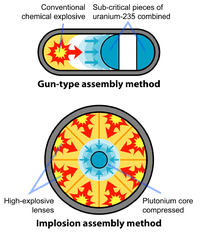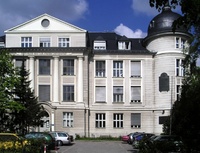2011年08月10日
日本(39)-旧帝国陸海軍の核兵器開発(11)

(旧暦7月11日)
西鶴忌
元禄6年(1693)、『好色一代男』などで知られる江戸期の浮世草子の創始者、人形浄瑠璃作者、俳人、井原西鶴(1642〜1693、本名平山藤五)の忌日。『源氏物語』の光源氏か『好色一代男』の世之介か、『四畳半襖の下張』の金阜山人か、はたまた『失楽園』の久木祥一郎か・・・。
日本(38)-旧帝国陸海軍の核兵器開発(10)のつづき
イギリスに亡命したユダヤ人の理論物理学者ルドルフ・エルンスト・パイエルス(Rudolf Ernst Peierls、1907~1995)とオットー・フリッシュ (Otto Robert Frisch、1904~1979)が作成した原子爆弾の可能性を論じた二種類の覚書(The Frisch-Peierls memorandum)は、当時、彼らが所属していたバーミンガム大学物理学科の主任マーク・オリファント(Marcus Laurence Elwin Oliphant、1901~2000)により、1940年3月19日、防空科学調査委員会(The Committee on the Scientific Survey of Air Defence)の文民議長であったオックスフォード大学のサー・ヘンリー・ティザード(Sir Henry Thomas Tizard 、1885~1959) へ届けられました。
フリッシュ−パイエルスの覚書(The Frisch-Peierls memorandum)を受け取ったティザードは検討の後、1940年4月10日、専門の科学者からなる小委員会を結成しました。 そして、その議長には、インペリアル・カレッジ(Imperial College of Science, Technology and Medicine)の物理学者で、中性子の衝突実験を行い、ウラニウムの核分裂連鎖反応には懐疑的であったG・P・トムソン(George Paget Thomson、1892〜1975)を就任させました。
また、そのメンバーには、前述のマーク・オリファントの他、ウラン235の高速中性子核分裂の実験を行っていたジェームズ・チャドウィック(Sir James Chadwick、1891〜1974)の助手のフィリップ・ムーン (Philip Burton Moon、1907〜1994)やα線やβ線を発見した著名な物理学者アーネスト・ラザフォード(Ernest Rutherford, 1871〜1937)の弟子であるジョン・コッククロフト(Sir John Douglas Cockcroft、1897〜1967)など錚々たる科学者を加えました。
1940年4月10日に王立協会で開かれたトムソン委員会と呼ばれる最初の非公式な会合では、ウラニウム235の核分裂連鎖反応による原子爆弾の可能性を論じたフリッシュ−パイエルスの覚書(The Frisch-Peierls memorandum)は懐疑的に受け取られていましたが、同年4月24日の2回目の会合では、参加したジェームズ・チャドウィック(Sir James Chadwick、1891〜1974)の「同様な結論に到達したが、実験による中性子吸収断面積についてのさらなる情報を得てからでないと報告できないと思っていた。」という告白により、委員会はウラニウムの同位体分離の技術開発に多大の注意を払うようになりました。
同年6月の下旬、議長のG・P・トムソンは、彼らの活動内容を偽装するために、彼の委員会に「MAUD」という名称をつけました。
ウラニウムの同位体分離技術については当初、1938年にドイツの物理化学者クラウス・クルジウスによって考案された、垂直二重円筒の内外温度差を利用して同位体を分離するクルジウス管による熱拡散法(Thermal diffusion method)が検討されていましたが、1940年6月、ドイツからオックスフォード大学クラレンドン研究所に招聘されていた化学者フランシス・サイモン (Francis Simon、1893〜1956)によって、気体が多孔性物体の中を拡散する時に分子量の軽い気体ほど早く拡散するというグレアムの法則(Graham's law)を応用した気体拡散法 (Gaseous diffusion method) が最も有望であると結論されました。
ウラニウムを気体拡散法で同位体分離するには、約 56.5 ℃ で昇華して気体になる六フッ化ウランを用います。単体の金属ウランを気化させるには沸点3745 ℃の高温を維持しなければなりませんが、六フッ化ウランは沸点が低いために、気体状態を維持するのが容易になります。
沸点の低い六フッ化ウランを用いた場合、理想的な条件下でもその濃縮比は1.0043 程度に過ぎませんが、このプロセスを繰り返すことによりウラン235の割合をほぼ100%まで近づけることができます。
昭和16年(1941)7月15日、MAUD 委員会はウラン爆弾は実現可能だとする最終報告を承認し、解散しました。 その報告書によれば、爆弾に含まれるウラン235は25ポンド(約11㎏)となり、その破壊力は TNT火薬1,800トンに相当し、大量の核分裂生成物を生じるとされました。 また、1943年末には爆弾製作の資材が提供可能となるとしました。

Otto Robert Frisch(1904~1979)
The MAUD Report, 1941
Report by MAUD Committee on the Use of Uranium for a Bomb
MAUD委員会報告、1941
MAUD委員会による爆弾としてのウラニウム利用における報告
OUTLINE OF PRESENT KNOWLEDGE
現在の知識の概要
1. General Statement
概説
Work to investigate the possibilities of utilizing the atomic energy of uranium for military purposes has been in progress since 1939, and a stage has now been reached when it seems desirable to report progress.
ウラニウムの核エネルギーを軍事目的に利用することの可能性を調査する作業は、1939年以来進行中であったが、状況は今や、その経過を報告することが望ましいと思われる段階に達した。
We should like to emphasize at the beginning of this report that we entered the project with more skepticism than belief, though we felt it was a matter which had to be investigated. As we proceeded we became more and more convinced that release of atomic energy on a large scale is possible and that conditions can be chosen which would make it a very powerful weapon of war.
我々はウラニウム核エネルギーの軍事利用が調査されるべき問題であることを認識してはいたが、この報告書の始めにおいて、我々はかなり懐疑的な態度でこの計画に取り組んだことを強調しなければならない。
調査が進むにつれて、我々は膨大な核エネルギーの放出が可能であること、そしてそれは戦争のための非常に強力な武器として選択できるということを、ますます確信するようになった。
We have now reached the conclusion that it will be possible to make an effective uranium bomb which, containing some 25 lb of active material, would be equivalent as regards destructive effect to 1,800 tons of T.N.T. and would also release large quantities of radioactive substance, which would make places near to where the bomb exploded dangerous to human life for a long period.
いまや我々は、有効なウラニウム爆弾を作ることが可能だという結論に達した。25ポンド(約11㎏)ほどの活性物質を含むその爆弾は、TNT火薬1,800トンに匹敵する破壊力を有し、また大量の放射性物質を放出するであろう。またその爆弾が爆発すれば、その地域は長期間にわたって人間の生命に危険をもたらすであろう。
The bomb would be composed of an active constituent (referred to in what follows as -U) present to the extent of about a part in 140 in ordinary Uranium.
その爆弾は、通常ウランの約140の範囲に存在する活性物質(以下Uと呼ぶ)から成る。
Owing to the very small difference in properties (other than explosive) between this substance and the rest of the Uranium, its extraction is a matter of great difficulty and a plant to produce 2-4 lb (1 kg) per day (or 3 bombs per month) is estimated to cost approximately 95,000,000 pounds, of which sum a considerable proportion would be spent on engineering, requiring labour of the same highly skilled character as is needed for making turbines.
この物質(U235)と残りのウラン(U238)との間の特性(爆薬以外の)の非常に小さな差のために、その抽出は大変な困難な問題であり、1日2〜4lb(1kg)(または1ヵ月につき3個の爆弾)を生産する施設はおよそ9,500万ポンドかかると見積もられる。その費用についてはかなりの部分が技術処理に費やされ、タービンを製造するために必要であるのと同様の非常に熟練した特質の労動力を必要とする。
In spite of this very large expenditure we consider that the destructive effect, both material and moral, is so great that every effort should be made to produce bombs of this kind. As regards the time required, Imperial Chemical Industries after consultation with Dr. Guy of Metropolitan--Vickers, estimate that the material for the first bomb could be ready by the end of 1943. This of course assumes that no major difficulty of an entirely unforeseen character arises. Dr. Ferguson of Woolwich estimates that the time required to work out the method of producing high velocities required for fusing (see paragraph 3) is 1-2 months. As this could be done concurrently with the production of the material no further delay is to be anticipated on this score. Even if the war should end before the bombs are ready the effort would not be wasted, except in the unlikely event of complete disarmament, since no nation would care to risk being caught without a weapon of such decisive possibilities.
この非常に大きな負担にもかかわらず、我々は破壊的な影響(材料と道義的な面において)は、この種の爆弾を生産するためにはあらゆる努力が払われなければならないほど大きいと考える。
必要な時間に関しては、メトロポリタン・ヴィッカース社のGuy博士との協議の後、インペリアル・ケミカル・インダストリーズ社が、最初の爆弾のための材料は1943年以内に準備可能であると推測している。
このことは、もちろん、まったく思いがけない性格の大きな困難が起こるというわけではないことを考えている。
ウーリッジ(Woolwich;ロンドン南東部)のファーガソン博士は、融合させる(第3節参照)ために必要とされる高速を生じる方法を解決するための必要な時間は1〜2ヵ月であると考えている。
このことは、材料の生産と並行してもうそれ以上の遅延は許されなかったので、この範囲で予想されることになっている。
爆弾が準備ができる前にたとえ戦争が終わらなければならないとしても、完全な軍備縮小の場合になること以外には、努力は無駄にならない。なぜなら、国がそのような決定的な可能性をもつ武器なしで危険を冒したいとは思わないからだ。
We know that Germany has taken a great deal of trouble to secure supplies of the substance known as heavy water. In the earlier stages we thought that this substance might be of great importance for our work. It appears in fact that is usefulness in the release of atomic energy is limited to processes which are not likely to be of immediate war value, but the Germans may by now have realized this, and it may be mentioned that the lines on which we are now working are such as would be likely to propose themselves to any capable physicist.
By far the largest supplies of Uranium are in Canada and the Belgian Congo, and since it has been actively looked for because of the radium which accompanies it, it is unlikely that any considerable quantities exist which are unknown except possibly in unexplored regions.
我々は、ドイツが重水として知られている物質の供給を確保するために多くの労力を要したということを知っている。初期の段階では、我々はこの物質が我々の仕事のためには非常に重要であるかもしれないと考えた。
事実、原子力の放出が即効性のある戦争に対する価値を持っている可能性が高くないプロセスに限定されているように思われるが、ドイツ人は今ごろこのことを理解しているかもしれない。そして、どんなに有能な物理学者にでもそれら自身を示唆する可能性が高いであろうように、我々が現在働いている線がそうであると言われるかもしれない。
飛び抜けてウランの最も大きな供給はカナダとベルギー領コンゴにあり、そして、ウランがそれに伴うラジウムのために活発に探されてきたが、多分未踏の地域以外で未知のどんな量でも存在することはありそうもない。
(中略)
8. Conclusions and Recommendations
結論及び勧告
(i) The committee considers that the scheme for a uranium bomb is practicable and likely to lead to decisive results in the war.
委員会は、ウラニウム爆弾計画は実現可能であり、この戦争において決定的な結果をもたらすものと考える。
(ii) It recommends that this work be continued on the highest priority and on the increasing scale necessary to obtain the weapon in the shortest possible time.
この作業は可能な限り最短の時間で兵器(ウラニウム爆弾)を得るために、最優先かつ規模を拡大して継続されるべきことを勧告する。
(iii) That the present collaboration with America should be continued and extended especially in the region of experimental work.
アメリカとの現在の協力は継続され、特に実験面で拡大されるべきである。
温和しくつづく
日本(40)-旧帝国陸海軍の核兵器開発(12)
日本(38)-旧帝国陸海軍の核兵器開発(10)
日本(37)-旧帝国陸海軍の核兵器開発(9)
日本(36)-旧帝国陸海軍の核兵器開発(8)
日本(35)-旧帝国陸海軍の核兵器開発(7)
日本(34)-旧帝国陸海軍の核兵器開発(6)
日本(38)-旧帝国陸海軍の核兵器開発(10)
日本(37)-旧帝国陸海軍の核兵器開発(9)
日本(36)-旧帝国陸海軍の核兵器開発(8)
日本(35)-旧帝国陸海軍の核兵器開発(7)
日本(34)-旧帝国陸海軍の核兵器開発(6)
※このブログではブログの持ち主が承認した後、コメントが反映される設定です。









